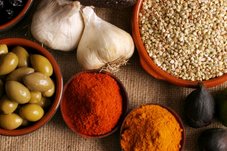In my days of teaching in academia I would ask my students a very simple question: “What is American food?” The answers in response were as varied as the faces in the classroom. Often heated debate would ensue with no resolution in sight. The final verdict reached, we all agreed that each response in its part was correct.
American food and cooking is like a patchwork quilt, colorful and varied pieces of fabric stitched together in small pieces over a long period of time. Food and cooking, regardless of the style, is and always has been an evolutionary process. Factors such as economics, religion, politics, culture, environment, education, migration and travel have historically impacted the process. Any great cuisine of the world is based on local varieties and on mutual exchange and enrichment. At the same time these cuisines are pleasingly blended and balanced by a metropolitan tradition of refined tastes.
The United States of America is an immigrant nation and a nation of immigrants. History begins with the Native Americans followed by the first European colonists. New immigrants came from Europe and later from Asia at different times in our nation’s history for various reasons, eager to establish themselves in their new communities, adapting as they could to the American way, learning to substitute and use American foodstuffs, creating new dishes with their traditional cooking style. Each group has contributed in their own way to the formation of American food both regional and ethnic.
One of the most concise and thorough texts written about the history of American food is American Food, The Gastronomical Story, by Evan Jones (Random House, 1981).
Mr. Jones writes “The true style of American food is the sum of many parts…Much of the best indigenous food is simple but good. Abundance and the quality and variety of raw ingredients are basic to the American way with food, and they have been from the earliest years. Basic too is the assimilation of ideas from many other cuisines.” How aptly put. American food is the sum of many parts.
In the days of our colonial ancestors foods were mostly fresh or home preserved. At the end of the 18th century American were predominantly a rural people drawing their existence from working the land. As modes of transportation were developed cities became centers of commerce and the exchange of goods. Foods changed through experimentation of horticultural practices creating new variations of fruits and vegetables. Greater varieties of food products became available. With mobility food habits and eating styles change rapidly. Industrialization gave birth to commercially preserved and manufactured foods creating a new culture of eating meals in a hurry.
Not all Americans are trapped in this culture of eating to merely satisfy hunger. Many are taking time out to try some of the treasured recipes their grandparents enjoyed. Our rich culinary heritage and traditions are worth being treasured and preserved.
The 1980’s spawned a renewed interest in American cooking. Innovative New American chefs have taken new approaches creating dishes based on tradition, native ingredients and a melting pot of cooking styles. As we moved into the 21st century, American cuisine has truly become global. Ingredients and cooking styles abound from all parts of the world, the best coming from our own native soil. Regardless of whether the dishes are based on tradition or innovation, one thing is for certain. In the words of David Rosengarten, “It’s all American food”!
